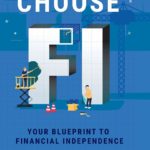
By Michael J. Wiener
Special to the Financial Independence Hub
Many of us dream of financial independence. Chris Mamula, Brad Barrett, and Jonathan Mendonsa offer many practical ideas for achieving financial independence (FI) and enjoying the journey along the way in their book Choose FI: Your Blueprint to Financial Independence. They avoid many of the problems we see in the FIRE (Financial Independence Retire Early) book category.
The authors avoid the biggest problem with most FIRE books. It’s annoying to tell the story of a high-income earner deciding to live like a student his whole life and retire in his 30s, and then say “you can too!” Although I point out the bad parts of books, I can forgive a lot if my mind is opened to a good idea. For this reason, I’ve enjoyed FIRE books even if they have some bad parts. This book manages to avoid the worst parts of other FIRE books.
The authors don’t bother much with retirement. FI gives us choices so we can “scrap the idea of retirement completely and focus on building lives we don’t want to retire from.” The life you build can involve paid work, leisure, or any other pursuit you want.
Rather than focus on just one story, the authors draw from the experience of many people who have sought FI. A common theme is the importance of enjoying the journey. If you see your pursuit of FI as suffering for several years until you hit your magic number, you’re not doing it the right way.
FI’s benefits start even before you reach the target
You benefit from pursuing FI even before you reach your target. “If you have a mortgage, a couple car payments, a family to feed, and nothing in the bank, what choice do you have when your boss asks you to do something stupid?” I was able to push back somewhat with my boss in the late part of my career, and this got me more money and autonomy.
If reaching FI seems like an unattainable goal, it may help to break it down into milestones. The authors suggest “getting to zero” for those in debt, “fully funded emergency fund,” “hitting six figures” in your portfolio, “half FI,” “getting close,” “FI,” and “FI with cushion.” This last stage is defined as having a portfolio equal to 33 times your annual spending needs. This is a sensible target for a young person with a long remaining life who doesn’t really know how spending needs will change with age.
The bulk of the book is organized around the main themes of achieving FI: spend less, earn more, and invest better. In the spend less theme, the idea is to align your spending with your values. Once you figure out what’s important to you, it becomes easier to cut out spending inconsistent with your values. Once you settle on how to spend, “What you spend, not what you earn, determines how much you need to achieve FI.”
Here’s a vivid explanation of the spending problem: “We found ourselves working non-stop to pay for a house we couldn’t enjoy, cars that were losing value while being used primarily for getting us to and from work, and unhealthy restaurant meals we ate because we didn’t have time to shop and cook for ourselves.”
Lean FIRE vs Fat Fire
The book gives examples of different people who have pursued “lean FIRE” and “fat FIRE.” We’re familiar with lean FIRE examples where people cut their expenses to easily-ridiculed levels. But fat FIRE, where you retain some of the finer things in life is possible as well. It takes longer, but you may enjoy the ride a lot more.
One area where it’s possible to save a lot of money is housing. Sharing housing is a good way to cut expenses drastically, “but there is a stigma associated with living with roommates as adults. Why is there no stigma to living paycheck to paycheck in houses or apartments that destroy wealth?”
One of the expenses that goes down as you become wealthier is insurance. For example, you generally don’t need life insurance if you’re FI. However, as you become wealthier, umbrella insurance may be a good idea. “If you were successfully sued, it could have a significant impact on your finances.”
The section on spending less ends with the suggestion to see the world and how others live to get ideas on how you might be happier living differently. A good quote from Mark Twain: “Travel is fatal to prejudice, bigotry, and narrow mindedness, and many of our people need it sorely on these accounts.”
In the section on earning more money, the book is critical of the advice to “follow your passion.” They say it’s better to “find a career that interests you and allows you to earn a solid income. Then learn to love it, or at least like it, while saving a high percentage of your income, allowing you to achieve FI quickly.”
The section on index investing is excellent. It took me a long time to learn the wisdom in these few pages. The hardest part for me to finally accept is that “thinking you can improve investment results by developing your investment skill is likely to do more harm than good.”
Sensible changes to the 4% Rule
The 4% rule for retirement spending isn’t too bad for a 60-year old (although I always suggest being prepared to adapt your spending level if your portfolio doesn’t generate the returns you planned). However, the 4% rule is not well-suited to young retirees because of the length of their retirements and uncertainty in how their spending will change with age. The authors suggest some sensible changes to the 4% rule. The first is to drop it to a 3.5% rule, and the second is to build a buffer into yearly expenses.
The authors discuss two other ways to invest, building a business and real estate, although they make it clear that index investing is an easier path. A good quote on building a business from Lori Greiner: “Entrepreneurs are the only people who will work 80 hours a week to avoid working 40 hours a week.” The authors also warn readers that stories of business success “have a massive selection bias, focusing on the ‘unicorns’ who made it while ignoring the many others who, despite taking risks, fail anyway.”
It’s important to emphasize the benefits you get from pursuing FI before you actually reach the destination. “Having the financial freedom to live life on your own terms is the ultimate reason to Choose FI. Take a minute to reflect on the idea that you don’t have to wait until you hit a magic number or a certain age to retire and experience that freedom. You begin to gain more freedom the day you Choose FI.”
One warning I have is for the many of us who get enthusiastic about an activity, say skiing, and buy expensive gear and clothing before discovering we’re not really skiers. It’s possible to sink a lot of time on FIRE blogs and attend FIRE events without ever doing anything to pursue FI. It’s better to make a few positive changes in your life than it is to just dream and contribute revenue to FIRE blogs.
In conclusion, this book has a lot of great suggestions for improving your life, and it avoids many of the problems pointed out by FIRE critics. If you think you may not be on the right financial path in your life, this book may be for you.
 Michael J. Wiener runs the web site Michael James on Money, where he looks for the right answers to personal finance and investing questions. He’s retired from work as a “math guy in high tech” and has been running his website since 2007. He’s a former mutual fund investor, former stock picker, now index investor. This blog originally appeared on his site on December 16, 2020 and is republished on the Hub with his permission.
Michael J. Wiener runs the web site Michael James on Money, where he looks for the right answers to personal finance and investing questions. He’s retired from work as a “math guy in high tech” and has been running his website since 2007. He’s a former mutual fund investor, former stock picker, now index investor. This blog originally appeared on his site on December 16, 2020 and is republished on the Hub with his permission.


